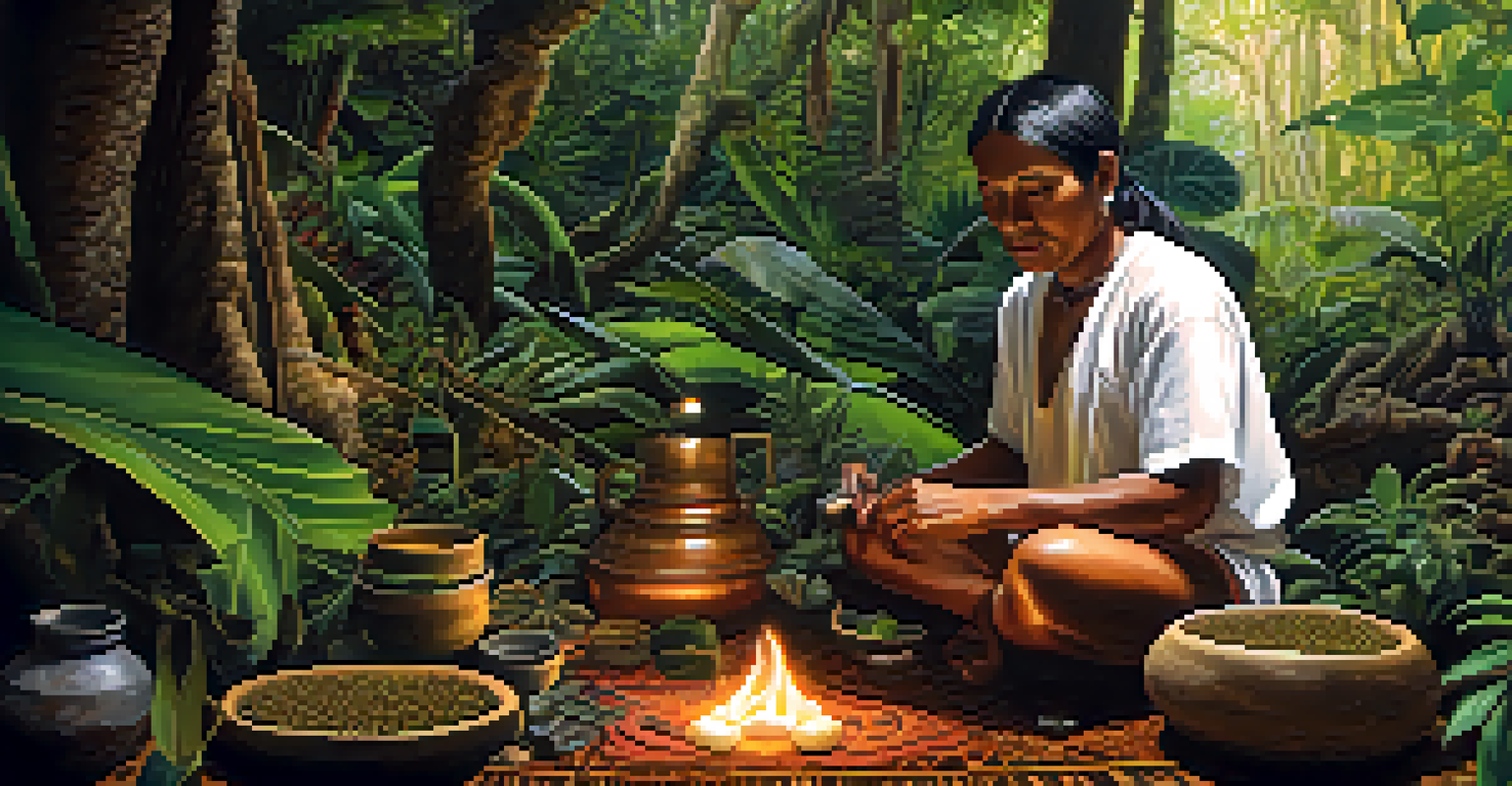The Connection Between Ayahuasca and Natural Environments

Understanding Ayahuasca: A Sacred Plant Medicine
Ayahuasca is a traditional plant-based brew, primarily made from the Banisteriopsis caapi vine and the Psychotria viridis leaf. This concoction has been used for centuries by indigenous communities in the Amazon for both healing and spiritual purposes. The brew is renowned for its psychoactive properties, which can lead to profound experiences and insights.
In every walk with nature one receives far more than he seeks.
The connection between Ayahuasca and its natural environment is crucial, as the potency of the brew is deeply rooted in the specific plants used and their growing conditions. The Amazon rainforest, with its rich biodiversity, provides the perfect ecosystem for these plants to thrive, showcasing a beautiful example of nature's interconnectedness.
Moreover, the knowledge of how to find, prepare, and use Ayahuasca is passed down through generations, highlighting the importance of cultural practices and environmental stewardship. This relationship emphasizes not only the significance of the plants but also the vital role of the natural world in shaping human experiences.
The Role of the Amazon Rainforest in Ayahuasca
The Amazon rainforest isn't just a backdrop; it's a living entity that plays a pivotal role in the Ayahuasca experience. This lush environment is home to numerous species that contribute to the brew’s effectiveness, showcasing nature’s remarkable ability to create complex ecosystems. The diverse flora and fauna contribute to the spiritual and healing properties that many seek when consuming Ayahuasca.

As a biodiverse hotspot, the Amazon provides the necessary conditions for the growth of the Ayahuasca vine and the accompanying plants. Each element interacts in a delicate balance, demonstrating how the health of the rainforest directly influences the quality and potency of Ayahuasca. When the rainforest thrives, so does the medicine.
Ayahuasca's Roots in the Amazon
The brew's effectiveness is deeply tied to the unique biodiversity and cultural practices of the Amazon rainforest.
Additionally, the rituals surrounding Ayahuasca ceremonies are often conducted in nature, further deepening the bond between the brew and its environment. Participants frequently report feeling more connected to the natural world during their journeys, illustrating how Ayahuasca invites them to appreciate the beauty and intricacies of their surroundings.
Ayahuasca's Influence on Environmental Awareness
Participating in Ayahuasca ceremonies often leads to heightened ecological awareness among individuals. Many users recount experiences that reveal their interconnectedness with nature, fostering a sense of responsibility towards environmental conservation. This perspective shift can inspire people to take action, whether through activism or sustainable practices.
The earth has music for those who listen.
The spiritual insights gained from Ayahuasca can motivate individuals to engage more deeply with their surroundings. For some, this means committing to protecting endangered habitats or advocating for sustainable land use. As a result, the impact of these ceremonies can extend beyond personal healing, sparking a broader movement towards ecological mindfulness.
Furthermore, as interest in Ayahuasca grows globally, there's an increasing emphasis on preserving indigenous knowledge and protecting the Amazon rainforest. This phenomenon showcases how the journey of self-discovery can simultaneously lead to a greater appreciation for the natural world and the urgent need to safeguard it.
Cultural Practices Surrounding Ayahuasca and Nature
Indigenous cultures that utilize Ayahuasca often have rich traditions that honor the natural world. These practices include sustainable harvesting methods that ensure the plants can continue to thrive for future generations. Such respectful approaches highlight the deep respect these communities have for their environment.
Rituals may involve offerings to the spirits of the plants, acknowledging the sacredness of the natural resources they depend upon. This reverence fosters a sense of stewardship, where the community sees itself as part of a larger ecological system. Thus, cultural practices surrounding Ayahuasca serve both to honor tradition and to promote environmental sustainability.
Environmental Awareness Through Ayahuasca
Experiences during Ayahuasca ceremonies often foster a heightened ecological consciousness and commitment to conservation.
As these traditions gain recognition beyond their native regions, they also inspire a global movement that seeks to integrate ecological consciousness into modern practices. This blending of ancient wisdom with contemporary environmentalism can lead to innovative solutions for protecting our planet.
The Therapeutic Benefits of Nature in Ayahuasca Journeys
Nature plays a crucial role in enhancing the therapeutic benefits of Ayahuasca. Many participants report that the serene beauty of the rainforest adds a layer of healing to their journeys. The sights, sounds, and scents of the natural environment can create a calming backdrop that deepens introspection and relaxation during the experience.
Research has shown that spending time in nature can reduce stress and promote emotional well-being, factors that can significantly enhance the Ayahuasca experience. The combination of psychedelic insights and the tranquil ambiance of the rainforest can lead to transformative healing moments that resonate long after the ceremony ends.
Furthermore, many retreat centers are strategically located in natural settings, allowing participants to immerse themselves fully in the environment. This holistic approach underscores the synergy between Ayahuasca and nature, emphasizing that the healing power of the brew is magnified when experienced in its natural habitat.
Challenges Facing the Amazon and Ayahuasca Practices
Despite the deep connections between Ayahuasca and the Amazon, the rainforest faces significant threats from deforestation, climate change, and exploitation. These challenges not only endanger the delicate ecosystems but also jeopardize the cultural practices tied to Ayahuasca. As the plants become rarer, the future of traditional ceremonies hangs in the balance.
Moreover, the growing popularity of Ayahuasca outside of indigenous communities can lead to unsustainable harvesting practices. This commercialization risks undermining the very traditions that have safeguarded Ayahuasca for centuries. If not approached with respect and mindfulness, the surge in demand could devastate the natural resources that many rely upon for their spiritual and physical well-being.
Challenges Facing Ayahuasca Practices
Deforestation and commercialization threaten both the Amazon ecosystem and the traditional practices surrounding Ayahuasca.
Addressing these challenges requires a collective effort to advocate for both environmental protection and the preservation of indigenous knowledge. Collaborative initiatives that involve local communities, conservationists, and consumers can help ensure that Ayahuasca practices continue sustainably, honoring both the plant and the people who have cherished it for generations.
Future Directions: Ayahuasca, Nature, and Conservation
Looking ahead, the relationship between Ayahuasca and natural environments presents an opportunity for fostering conservation efforts. Educating people about the significance of these plants and their ecosystems can encourage sustainable practices and deeper connections with nature. By sharing the stories and traditions surrounding Ayahuasca, we can cultivate a greater appreciation for the Amazon and its rich biodiversity.
Additionally, promoting eco-tourism that respects indigenous practices can provide economic benefits while safeguarding the environment. This approach can help local communities thrive while ensuring that their knowledge and traditions are preserved. By creating a balance between tourism and conservation, we can protect the very ecosystems that make Ayahuasca possible.

Ultimately, the future of Ayahuasca is intertwined with the health of the Amazon rainforest. As awareness grows, it is essential to prioritize efforts that celebrate both the spiritual and ecological significance of this sacred brew, ensuring that it continues to inspire and heal for generations to come.